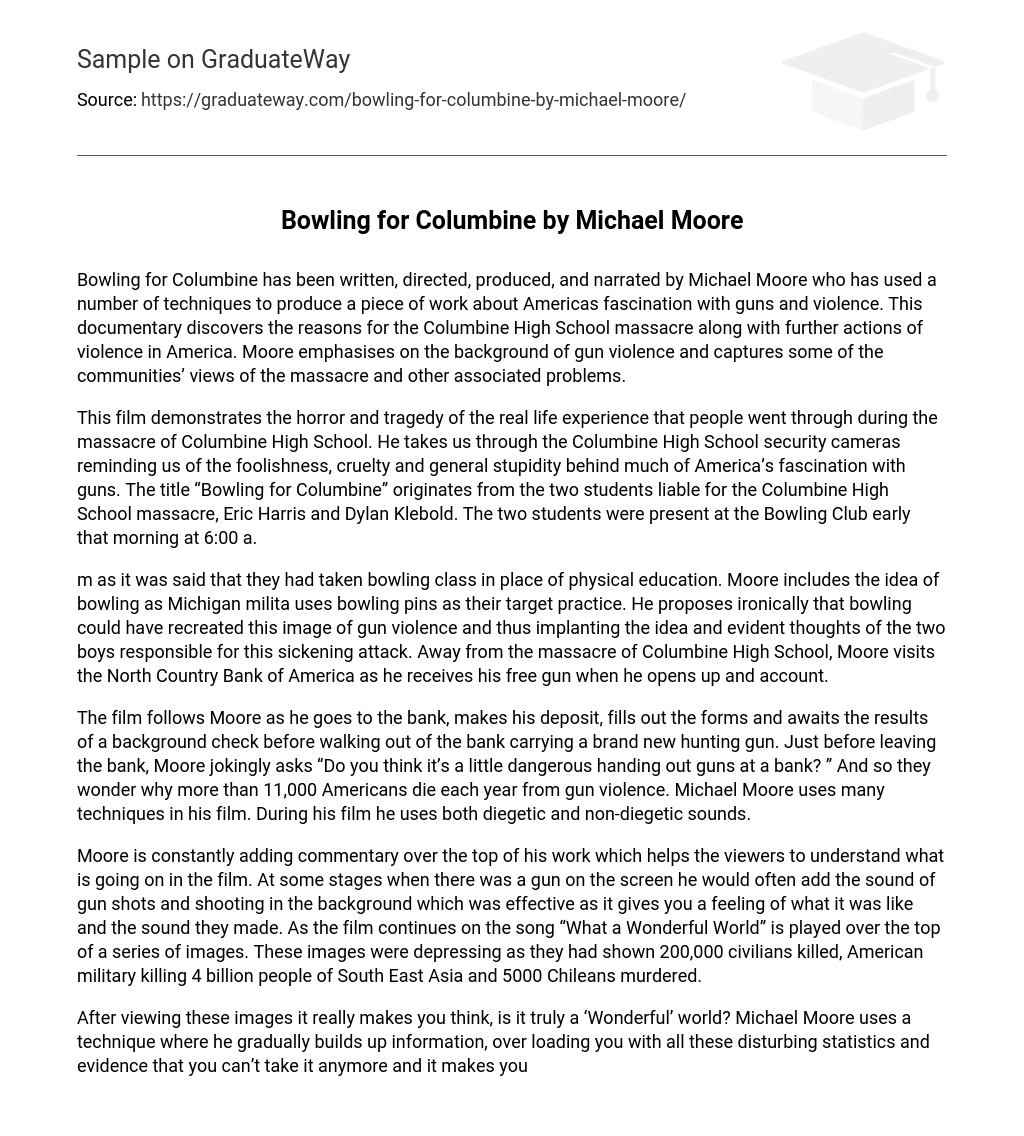In the documentary Bowling for Columbine, Michael Moore explores America’s obsession with guns and violence. Moore takes on multiple roles in the film, serving as its director, writer, producer, and narrator. Through various techniques, he delves into the causes behind the Columbine High School shooting and other acts of violence in the country. Furthermore, Moore illuminates the historical context of gun-related aggression and presents diverse viewpoints from communities impacted by this tragedy.
This documentary film titled “Bowling for Columbine” uncovers the horror and tragedy of the actual events that took place during the Columbine High School massacre. By utilizing the school’s security cameras, the filmmaker brings to light the irrationality, brutality, and overall absurdity often linked to America’s fascination with firearms. It is worth noting that Eric Harris and Dylan Klebold, who carried out the massacre, were members of the school’s Bowling Club and were present at 6:00 am on the day of the incident.
The article discusses how rather than participating in physical education, they opted for a bowling class. Michael Moore draws a connection between this choice and the Michigan militia’s utilization of bowling pins as targets during practice. He cynically suggests that the act of bowling may have inadvertently contributed to promoting gun violence and influenced the two boys involved in the tragic attack at Columbine High School. Shifting focus from this distressing incident, Moore visits North Country Bank of America where he is given a complimentary firearm upon opening an account.
The film focuses on Moore’s visit to the bank, where he completes a deposit and paperwork. He then awaits the outcome of a background check before leaving the bank with a newly acquired hunting gun. Right before his departure, Moore humorously questions the safety of handing out guns at a bank. It raises the question as to why more than 11,000 Americans lose their lives to gun violence each year. To enhance his film, Michael Moore employs various techniques, including diegetic and non-diegetic sounds.
Moore consistently provides commentary throughout his work, helping viewers understand the events depicted in the film. At times, he enhances the scenes with audio effects like gunshots, effectively conveying the feeling and sound of the situations portrayed. Continuing in the film, a series of images is accompanied by the song “What a Wonderful World.” These images are disheartening, depicting the deaths of 200,000 civilians, the American military’s killing of 4 billion people in Southeast Asia, and the murder of 5000 Chileans.
After watching these pictures, it really prompts reflection on whether the world is truly ‘Wonderful’. Michael Moore employs a method where he progressively presents data, inundating you with unsettling statistics and evidence to the point where you can no longer endure it, and it evokes sadness. The information gradually affects you, as does his message of attempting to convince us that gun violence in America has reached an excessive level! Moore utilizes various techniques that encourage deep contemplation about his assertions, causing us to ponder whether gun violence in America has gone beyond reasonable limits?
Is there a solution to their fixation on firearms? This film uncovers various forms of conflict including physical, emotional, societal, and school conflict. Such conflicts can cause significant harm to both humanity and the environment. The primary conflict depicted in this film is physical conflict, which can be instigated by various factors, particularly the media. The media consistently portrays distressing scenes of gun violence to such an extent that it seemingly encourages viewers to engage in similar actions. Hence, the media captivates viewers, compelling them to imitate what they witness.
The normalization and acceptance of guns and violence among many Americans is primarily influenced by their upbringing. This mindset is strengthened through the pervasive presence of firearms in various contexts, such as warfare, movies, toys, and even admired celebrities. The exposure to these elements begins during childhood when children engage in play with toy guns and participate in violent video games. As they mature, they encounter increasingly explicit portrayals of gun violence in films until they are legally eligible to possess a firearm.
Due to limited knowledge, extensive exposure to gun violence can lead individuals to perceive it as an acceptable solution without proper guidance. This lack of understanding creates a scenario where everyone becomes similar, resulting in grave consequences. Instances like the Columbine High School massacre and the assault on the World Trade Centre demonstrate the prevalence of firearms and violence, causing significant loss of life. The attack on the World Trade Centre further showcases the devastating outcomes of conflict.
The 9/11 terrorist attacks had a profound impact on both humanity and the environment. The loss of 19 hijackers and nearly 3,000 other individuals resulted in immense devastation. A film was made to showcase the magnitude of these tragedies that can occur due to conflicts, as well as emphasize the significance of acknowledging and resolving such conflicts. In this film, two young boys were depicted as primarily responsible for harboring intense anger and frustration towards society, their own lives, and themselves.
In their case, the conflict originated from societal and school surroundings, but it was fueled by their constant exposure to violent thoughts and ideas sourced from the media, society, and violent pastimes. Although the boys encountered various forms of conflict, they lacked the desire to resolve it and instead utilized it to inflict terror and sadness upon those around them. This raises the question of whether the accessibility of these items due to United States laws and policies played a role in making this massacre slightly more feasible for the boys.





